"The grandest churchyard in England: far more memorable than the church itself".
This is the judgement of that formidable scholar, Alec Clifton-Taylor, in his definitive work The English Parish Church considered as a Work of Art. The majority of the notable tombs in Painswick churchyard were erected in the elegant Georgian era. It is fortunate for this town that this period coincided with local prosperity, immediate access to important limestone quarries in Painswick and in Minchinhampton and gifted local masons and carvers.
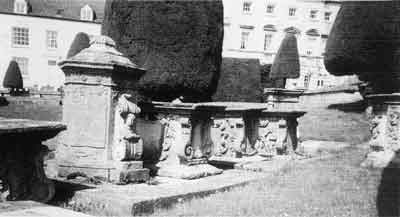
A general view showing different styles of tombs
[Nos. 92,91,93,94,95]
THE CHURCHYARD PLAN
For the extensive records of dates and inscriptions we are indebted to Cecil T Davis, son of Uriah Davis who lived and kept a school at the Court House in the late 19th century. Cecil, later Borough Librarian of Wandsworth and better known in this County as the author of Gloucestershire Brasses, listed all the inscriptions to be seen on the tombs in 1879. He supplemented his records from Bigland1 published earlier. He noted that some tombs listed in Bigland had already disappeared and some inscriptions had become illegible. Davis listed 590 tombs in total, of which 157 are now designated 'buildings of special architectural or historic interest'.2 Some of his notebooks are in the Gloucestershire Collection in the Gloucester Library.
In the early decades of the 20th century Max Clarke, a London architect, had been a frequent visitor to his friend, Ellis Marsland, who lived in the Court House. From 1902-1904 Clarke took many photographs of the tombs and also became acquainted with the notebooks of Cecil Davis.
In November 1916, Davis and Clarke met at the Holborn Restaurant to discuss a possible linkage of the Davis inscriptions and the Clarke photographs. Meanwhile Clarke, Marsland and H. M. Carter were undertaking a land survey of the churchyard. Finally the Davis data was incorporated in the survey to produce the definitive identification plan of 1926.3
Tomb numbers quoted in this article are taken from this plan.
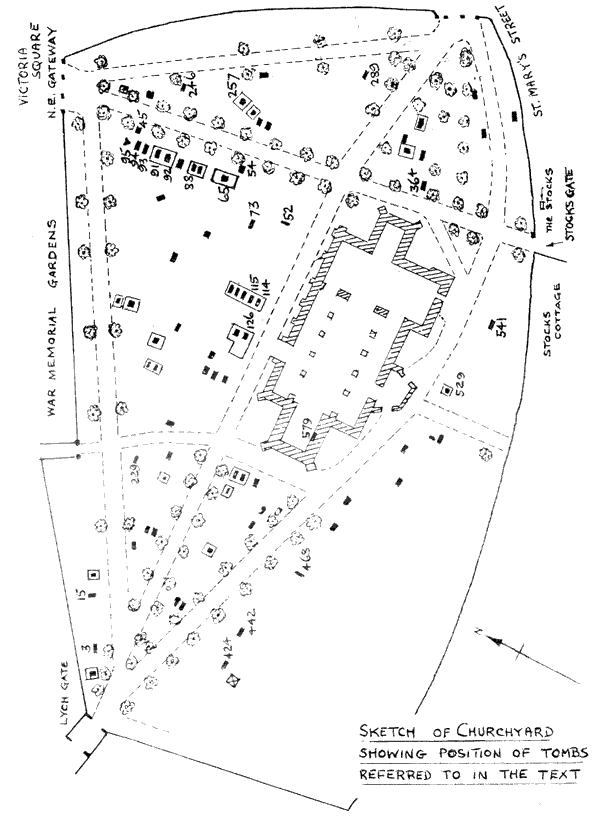
THE TOMBS
A wide variety of tomb designs, progressing from the upright headstone to the massive horizontal ledger, the chest, the pedestal and the tea caddy, are to be found in our churchyard. AII serve the same purpose of providing a surface on which, with varying degrees of ostentation, the name of a forebear may be kept in remembrance. The earliest chest tombs, devoid of ornament, were conceived as copies of those traditionally provided inside churches for wealthier families. Outside, the customary effigy was omitted. William Loveday, Yeoman, deceased the 20th May 1623, [No. 364] is the earliest to be seen in Painswick churchyard: a rectangular box of four panels secured by iron cramps, surmounted by a thick over-hanging slab, all standing on a moulded flared base.
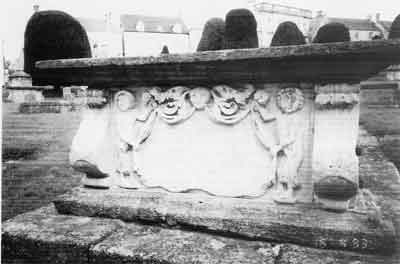
Chest tomb - Richard Poole, 1798 S.Side
[No. 114]
As the 17th century progressed end panels began to take on the shape of a lyre. An early example is that of 'John Poole, Gent 1667'. [No. 115] This new style develops to a console ending in a scroll resembling the volute of the Ionic capital, a feature of Palladian architecture. In the 18th century this ornamental character was interpreted in many materials, situations and orientations, notably on fireplace over-mantle supports, door cases and gable ends. Popular technical pattern books such as that published by the architect Batty Langley in 1750 - The Workman's Golden Rule for Drawing and Working the Five Orders of Architecture for the instruction of Apprentices and Journeymen, Masons, Bricklayers, Carpenters, Joiners, Carvers, Turners, Painters, Plasterers, Cabinet Makers - contributed significantly to the spread and standardisation of this classical element.
During the 18th century a modified form of the chest developed - the pedestal tomb. The height of tombs increased, the length diminished. The simple rectangular cross-section was no longer universal. The tops could be domed and sometimes finished with carved finials, as exemplified by the tomb of 'Henry Loveday of the Mill in this Parish, Yeoman 1781'. [No. 88]
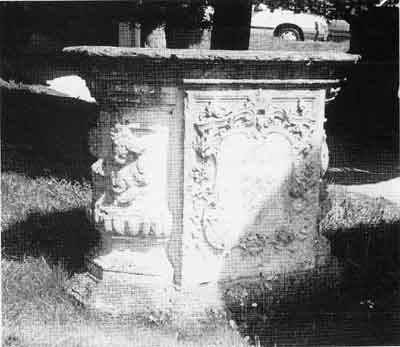
Pedestal tomb - Daniel Packer, Clothier, 1769
[No. 45]
The final development was an even taller tomb - the tea caddy - either cylindrical or hexagonal in section. The tea caddy form is essentially a Painswick creation. Our finest example, sadly much decayed, is that of 'John Gardner, Clothier 1793'. [No. 65] In appearance, a lofty cylindrical pedestal tomb, it is described in the 'listing'2 as having
"moulded capping to moulded edge over embellished frieze with inscription: 'IN MEMORY OF THE UNDERWRITTEN WHOSE REMAINS --- - -NTERRED', all supported by four richly modelled scrolls to moulded base. Sunk moulded curved panels. Set on a platform in Greek cross form, carrying four engraved plates to other members of the family. An unusual form of brilliant execution".
The earliest tombs show rough Roman lettering on plain side panels. Later, inscriptions were cut on elegant raised cartouches surrounded by deeply carved scallops, arabesques or suspended drapes, the latter held aloft by naked boys discreetly covered. The local limestone afforded a perfect medium to indulge the developing skills of the Painswick masons.
The latter half of the 18th century saw a profusion of work of the highest quality. Tombs became the outdoor canvas of master masons and sculptors. Symbols of life, death and eternity abound. The Book, Father Time with scythe, hour glass and feet on wheel, skeletons with feet on globes, bat-wing skulls, crowns of glory, torches and rays from heaven speak loudly of human mortality. Putti, angel faces, acanthus, fruit and flowers, the tools of masons and gravediggers and 'weepers' (cherubs with tear drops falling down mournful faces) are among the oft-repeated standard patterns.
The same limestone texture that had made this rich carving readily possible also contributed to the early erosion of the inscriptions. To overcome this problem brass plates were introduced on which the most sharply incised and elegant lettering could be engraved. Many plates carry exquisite marginal decoration and some are signed 'Hamlett', a Stroud craftsman. A headstone to an earlier Thomas Hamlett, who died 1783, "Mason of this Parish, Senior Free Mason". The stone bears the Mason's Arms and depicts mason's tools. [No. 15]
A regrettable attempt to secure permanence may be seen on the tomb of John Loveday, farmer of Holcombe, 1750, where a stone end panel of a pedestal tomb has been replaced by marble and reinscribed. [No. 126]
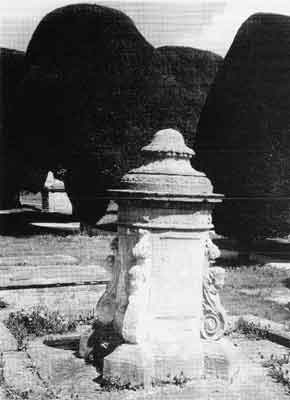
Tea Caddy tomb - John Gardner, 1793
[No. 65]
DATING
Memorials in churchyards are largely a Post-Reformation usage. In Painswick no Pre-Reformation memorial has been recorded.
The dating of tombs is sometimes uncertain. The tomb may not be contemporary with the first name and date recorded. Rising prosperity may have allowed a family to erect a memorial for themselves and to record on it details of recent ancestors. More surprisingly, the Supervising Lister for English Heritage considered from convincing design evidence that the John Cook tomb [No. 73] inscribed "Clerk of this Parish 1830" is actually late 17th or early 18th century. Doubtless with economy in mind, some inscriptions were carved in anticipation, with appropriate blank spaces left for later completion. On the tomb in memory of James and Ann Birt of this Parish [No. 442] it is recorded:

What happened to James?
MASONS
Little is known of the masons responsible for the Painswick tombs. Some of the best are ascribed to John Bryan. Born in Painswick in 1716, he, together with younger brother Joseph, founded a firm of masons in Gloucester. Joseph died in 1780, John in 1787; the firm continued under Joseph's son until it amalgamated with George Wood, finally ceasing trading in 1820. The documented work undertaken by the firm includes: a pair of gate piers at the north east entrance to Painswick churchyard (1747/48) for which they were paid ten guineas; the tower of Great Witcombe Church; and monuments in Winchcombe, Fairford, Rodmarton and Maisemore churches. An interesting feature of their carving in churches is a lively use of foreign marbles. That John worked for Painswick church is witnessed in the churchwardens' accounts:
1762 John Bryan for drawing plans for the north aisle £ 1.11. 6
1763 John Bryan part of his bill £ 5 . 5. 0
1772 John and Joseph Bryan in part of their bill for repairing the Tower £16. 9. 0
INSCRIPTIONS AND EPITAPHS
The inscribed names reflect the social history of Painswick. Clothiers abound: Bayliss (from 1797), Gardner (from 1712), Packer (from 1704) and Palling (from 1698). Other prominent families are the Pooles (from 1658) and the Lovedays (from 1623) inscribed variously as Gent., Yeoman or Clothier. The vigorous commercial life of the town is represented by salters, bakers, tallow chandlers, farmers, butchers, cordwainers and maltsters to list but a few. The death of a nurseryman, William Webb, on 21st July 1808 [No. 289] gave rise to an inquest reported in the Gloucester Journal of 8th August 1808.
"On Saturday sennight an inquest was taken at Painswick before W. Trigg Gent. Coroner and a respectable jury, on view of the body of Mr Webb, nurseryman who, previous to his dissolution, had stated before witnesses that his then melancholy situation had been occasioned by the ill usage of some person unknown".
In the Gloucester Journal of 23rd November 1795 an advertisement reads
"William Webb - Land Surveyor - Nursery and Seedsman.
For sale trees, plants and shrubs".
Did he provide some of the Painswick yews?
A later inquest explains the sudden death of John Gill, landlord of the Butcher's Arms, Sheepscombe, aged 31. [No. 52] The Gloucester Journal 7th January 1832 reports:
"Inquest at Shepscombe on body of John Gill, who was killed by the discharge of a gun. Thomas Davis, a boy of 15 was at a Barn belonging to the deceased's father, where a gun had been left loaded, which he took in his hand and was playing with it, when it suddenly went off and lodged the contents in the neck immediately under the right ear of he deceased".
Another bullet connects us with national history. Lieutenant Charles Cox of Damsells, who died on the 19th January 1875, aged 89
"Served his country through the Peninsular War and at Waterloo and bore to his grave a Bullet with which he was wounded at Vittoria".
A less fortunate contemporary, Capt. James Gardner of the 28th Regiment (later the Royal Gloucestershire Regiment) was mortally wounded at the Battle of Alexandria, 1801. The Regimental Association has recently refurbished his memorial situated by the south porch of the Church. [No. 529]
Family size, longevity and infant mortality are documented on stone and plate. A tablet in the town vestry [No. 579] with the names of 12 sons and daughters of William and Elizabeth Townsend, who died between 1727 and 1803, speaks of the size of some 18th century families. As now, Painswick had its senior citizens. Henry Jordan died in 1801 [No.3]: his epitaph reads
"Ninety three years on earth I spent
Then left my poor frail Tenement
In silent dust to remain
Till raised by Christ to life again."
The inscription on Thomas Parker's tomb reads "Thomas Parker, Yeoman, of Shepscombe in this Parish departed this life the 7th of June 1740. Aged near 100 years". [No. 54]
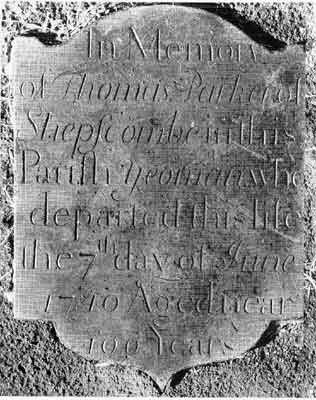
Inscription on Thomas Packers Tomb [No. 54]
Few families escaped the scourge of infant mortality. The Knight family tomb [No. 257] reads
"... also of Thomas their son died aged 13 years and of seven of their children who died in infancy"
With the passing of the Georgian age the quality of carving and lettering declined. Inscriptions hitherto confined to essential details gave way to epitaphs:
some popular: Samuel Cooke, 1815 [No. 541] and Thomas Clissold, 1818 [No. 246]
"Affliction sore long time I bore
Physicians were in vain
Till God alone did hear my moan
and eased me of my pain."
some descriptive: John Parker,Yeoman, 1799 [No. 229]
"As through the fields he walked alone
By chance he met grim death
Who with his dart did strike his heart
And robbed him of his breath."
some querulous: Richard Townsend, 1794 [No. 424]
"Farewell vain world, I've seen enough of thee
In grief and pain, sickness and misery.
Thy smiles I value not, nor frowns do fear
Thanks be to God, I sleep at quiet here
What fault you've seen in me, still strive to shun
And look at home, there's something to be done."
some, seemingly, self-selected: Frances Ann Digger 1825, aged 26 years [No. 468]
"When the archangels' trumpets blow
And souls to bodies join
What crowds will wish their stay below
Had been as short as mine."
VVEAR AND TEAR
The tombs have inevitably suffered through the years. Natural weathering, increased atmospheric pollution and the past use of some unsuitable stone have taken their toll. Spalling, often due to incorrect bedding, has rendered inscriptions illegible. Rusting iron cramps have split stone panels asunder. Physical impact has damaged mouldings, pilasters and carved figures. St. Clair Baddeley wrote
"It is a thousand pities that the tombs, some of the most remarkable in the country and worthy evidence of the skills and training of former local artists, should be the common playthings each day of the village school children as they come out of the opposite school"
Today, participants in the Clypping Service clamber on chest tombs and swing their heels against cherubic faces. Perhaps the 18th century iron rails that surrounded many tombs should be restored or the 1750 fine of ten shillings for anyone found damaging a tomb should be reimposed (suitably adjusted for inflation!).
CONSERVATION OR BENIGN DECAY?
A programme of conservation was begun in 1973. The first phase of repair included the carving by Jack Chant, master mason of Blockley, of replica panels and treatment with water repellant preservatives. Experience suggests that, after an initial promising period, these silicone-based products accelerated decay.
For a brief period from 1985 some chest tombs were dismantled, iron cramps replaced by stainless steel and internal brick piers built to relieve the side panels of the heavy load of the stone lid. Surfaces were treated using a lime-based procedure pioneered by Professor Baker. Carving on new panels was restricted to the minimum.
Many of the 18th century tombs are memorials to donors who made possible the building of the first south aisle of the Church. Should this heritage be allowed to crumble away as some in authority would wish? A notice at the entrance to the churchyard used to read
"The TOMBS in this churchyard are of EXCEPTIONAL VALUE. They are the work of the Forefathers of many still living here, and are a proud Trust for the People and Children of Painswick. It is particularly requested that VISITORS WILL RESPECT them."
As Clifton-Taylor perceptively commented
"It is hoped that the implication that inhabitants of Painswick will certainly do so is justified for this is the grandest churchyard in England."
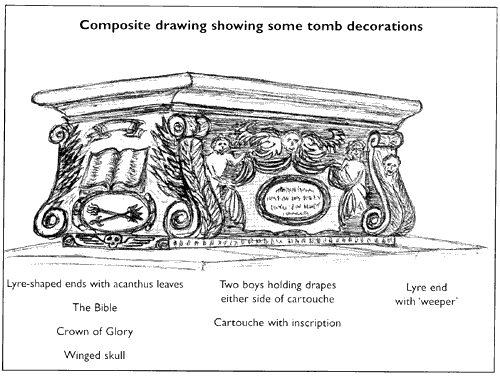
References